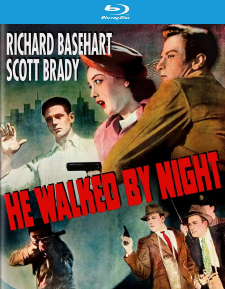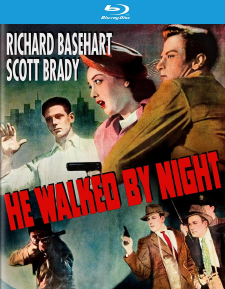He Walked by Night (Blu-ray Review)

Director
Alfred L. Werker/Anthony MannRelease Date(s)
1948 (January 30, 2024)Studio(s)
Bryan Foy Productions/Eagle-Lion Films (Kino Lorber Studio Classics)- Film/Program Grade: A-
- Video Grade: A
- Audio Grade: A
- Extras Grade: A
Review
He Walked by Night is inspired by the 1946 real-life story of disturbed World War II veteran Erwin Walker, who stole army weapons and used them in committing a series of burglaries to finance an invention that he hoped would end war for all time. Using his training before the war as a police dispatcher, Walker managed to stay ahead of the Los Angeles police for months and led to his murder of a California highway patrol officer.
The script is based loosely on these events, with Walker’s name changed to Roy Martin (Richard Basehart, La Strada). The opening scene recreates the murder with noir-ish lighting on deserted streets. Martin, just having tried to break into an electronics store, encounters a cop on his way home. The killing is sudden and unexpected, establishing Martin as a cold-blooded murderer.
The balance of the film switches back and forth between the police investigation to discover the identity of the killer and capture him, and Martin’s careful, step-by-step precautions to elude an extensive dragnet. These scenes involve making a composite sketch of the killer from witnesses, searching the abandoned getaway car, checking bullet cartridges, and combing the department’s data file to narrow the search.
Police Captain Sheen (Roy Roberts, Chinatown) and Police Sgt. Marty Brennan (Scott Brady, Gremlins) represent the face of the department as they diligently follow leads and use department resources to establish a profile of the killer. But each time it looks as if they have their man, Martin eludes them. What they don’t know is that he has a police radio and he’s listening in to anticipate their every move.
The credited director is Alfred Werker, but Anthony Mann directed several scenes when Werker couldn’t finish the picture, either because of illness or because he had moved on to another project. It was typical back then for more than one director to work on a film. The scenes directed by Mann are likely the ones with the noir touches, particularly the opening sequence of the murder and the finale, featuring a chase through the Los Angeles storm drains. This scene is shot with unusual angles, auras around street lamps, rain soaked streets, and a flashlight illuminating one section of the drain system at a time as Martin runs through the darkened enclosure.
Basehart is excellent as Martin. He plays the role as mild-mannered. With minimal dialogue, he delivers his character largely through facial expression and reactions. He can switch from soft-spoken to threatening in a second, making his Martin a frightening presence. Martin is a loner, friendly only to a small dog. Basehart makes him a memorable alienated noir protagonist.
He Walks by Night is primarily a police procedural, but with visual touches identified with noir that add considerable atmosphere. Establishing shots of Los Angeles and off-screen narration by Reed Hadley (Zorro’s Fighting Legion) suggest newsreels of the period. Made for just $300,000 by Eagle Lion, a “poverty row" studio associated with B movies, it’s fast paced, suspenseful, and has a strong supporting cast, including Whit Bissell (The Defiant Ones) as an electronics dealer who unwittingly rents equipment from Martin, James Cardwell (Daughter of the Jungle) as a detective, John Dehner (The Boys From Brazil) as the assistant bureau chief, Ann Doran (Rebel Without a Cause) as a dispatcher, Tommy Kelly (The Adventures of Tom Sawyer) as a juvenile delinquent, and John McGuire (Where the Sidewalk Ends) as the murdered policeman.
The film is notable for the presence of Jack Webb (Sunset Boulevard) as police forensics expert Lee Whitey. He met the technical advisor from the LAPD during production and spoke to him about the possibility of dramatizing cases from the department for a radio show. These conversations led to Dragnet, which later ran on television from 1951 to 1959 and, with a different cast, from 1967 to 1970. The TV series employed many elements of He Walked by Night, including off-screen narration, emphasis on cops investigating and solving cases, and a semi-documentary style.
He Walked by Night tracks a gripping manhunt for a cop killer. Since we know the murderer from the outset, the drama arises from the methodical work of the police to identify, locate, and capture him. Shot on a small budget, it nonetheless delivers an exciting portrait of a metropolitan police department using its resources, human and technical, to get a murderer off the streets.
Director of photography John Alton shot He Walked by Night on 35 mm black & white film with spherical lenses. It was presented in the standard Academy aspect ratio of 1.37:1. The Kino Lorber Blu-ray features a brand new master from a 16-Bit 4K scan of a 35 mm fine grain. Clarity and contrast are much improved over a 2017 release on ClassicFlix. Blacks are deep and rich, creating a dramatic contrast with the few sources of light. Details such as items on detectives’ desks, electronic equipment in Martin’s garage, forensic lab equipment, and furnishings in the electronics dealer’s home are well delineated. Alton’s compositions are always interesting, since he favors low and high angles rather than shots taken from eye level. This gives the film nice visual variety. The photography soars during the lengthy sequence in the storm drains of Los Angeles as Martin attempts to escape his pursuers. Water on the ground and walls reflects light from flashlights and creates elongated shadows and flickering patterns. Exteriors were filmed on the backlot. Assorted L.A. locations are seen as the cops drive to different locations, and Martin’s apartment is in an actual row of houses. The film is free of dirt specks, scratches, and other distracting imperfections.
The soundtrack is English 2.0 DTS-HD Master Audio. English SDH subtitles are available. Dialogue is clear and distinct. Reed Hadley’s voiceover narration will remind older viewers of the original Dragnet TV show with the character of Sgt. Joe Friday providing narration during each episode. Sound effects include gun shots, a car crash, machine gun fire, echoes in the storm drains as Martin runs through shallow streams of water, a body being pummeled, and the police dispatches Martin listens to in his garage.
Bonus materials on the Region A Blu-ray release from Kino Lorber include the following:
- Audio Commentary by Imogen Sara Smith
- Audio Commentary by Alan K. Rode and Julie Kirgo
- The Lodger Trailer (2:16)
- Calcutta Trailer (2:20)
- The Web Trailer (2:17)
- Cry of the City Trailer (2:33)
- Force of Evil Trailer (1:33)
- Kiss the Blood Off My Hands Trailer (1:37)
- The Lady from Shanghai Trailer (1:50)
- Alias Nick Beal Trailer (2:23)
- Night Has a Thousand Eyes Trailer (2:23)
- Detective Story Trailer (2:21)
- He Ran All the Way Trailer (2:14)
- The Turning Point Trailer (2:01)
- 9 River Street Trailer (2:14)
- Human Desire Trailer (1:57)
- Touch of Evil Trailer (2:12)
Audio Commentary #1 – Film historian Imogen Sara Smith refers to He Walked by Night as more a police procedural and true crime drama than film noir. She believes “semi-documentary” is misleading, since it was made like any other Hollywood film of the time. Narrator Reed Hadley provides a classic, authoritative yet calming voiceover. The shooting of the cop is “concise and unadorned,” making it all the more shocking. Film noir contains both expressionism and gritty realism. Documentaries of World War II by directors like John Huston and William Wyler gave audiences a taste for the documentary style as did the March of Time newsreels, breaking away from the polish of Hollywood studio productions. Poverty row studios adopted the style because they had foolproof appeal. Many films were “ripped from the headlines.” The details of the shooting in the film are close to what really occurred. The real killer was suffering from what today is referred to as PTSD. TV shows like Dragnet and Racket Squad would kill off low-budget crime features. Except for a brief scene in which the cop’s wife is informed of her husband’s death, the film contains no female characters. He Walked by Night marked the screen debut of Jack Webb, who was inspired by the film to create Dragnet. A brief overview of Webb’s screen work is provided, including Pete Kelly’s Blues, reflecting Webb’s love of jazz. He went on to create several additional TV series. This was Richard Basehart’s third feature film. He never became a big star but played a range of roles, mostly bad guys. The acting in Alfred Werner’s films tended to be uneven. Anthony Mann directed four scenes to finish the film. Mann’s scenes are the most “noir-ish,” especially the storm drain sequence. Film noir bucked traditional ideas of filming in terms of lighting, composition, shadows, and use of odd angles. B movies influenced future directors. Eagle Lion was established in 1944 for American releases of British films, most of which did not do well in the U.S. The company lasted only five years with projects using independent producers.
Audio Commentary #2 – This commentary from 2017 is shared by film historians Alan K. Rode and Julie Kirgo. He Walked by Night is one of the most effective portraits of Los Angeles of the period. The actual crime and its aftermath are discussed. A number of stock shots are used and integrated seamlessly. The actual cop who “collared” real killer Erwin Walker appears in a small role as a police officer. Walker set up his own garage workshop and supported himself through burglaries. When caught, he made a full confession. At trial, it was brought out that there was insanity in the family. He was released from prison in 1974. He never apologized for his crimes. Eagle Lion took over the former PRC studios, and later the property became the home of ZIV TV productions. The police roundups depicted “trampled on civil rights.” The attention to detail in the film is “phenomenal.” Compositions are well laid out. The L.A. sewer system is an uncredited co-star. The storm drain scenes were later re-used in the motion picture The Indestructible Man (1956) and were a major location in 1954’s Them!
He Walked by Night works as a taut thriller, even though we know the killer’s identity from the first scene. We know little about the killer’s background, which would have given the character more dimension. But making him an enigma may have been intentional, since we’re seeing him through the lens of the police trying to identify him. The real Walker came back from the war seriously disturbed, and this is completely ignored by the screenplay.
- Dennis Seuling

